|
In the historical district of Tondabayashi Jinaimachi, there remain as
many as forty old wooden-structured merchants' houses built during the
Edo period (the 17th - Mid. 19th centuries) and thenafter, as the whole
town looks like a movie location site and you can enjoy a time-slipping
journey here. The town area was designated as an important historical district
and heritage site of Japan. |
|
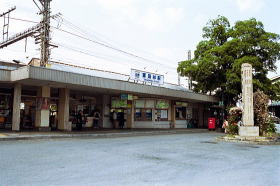 |
Tondabayashi Station on Kintetsu Railways Nagano Line ilinked to the website of Kintestu Railways) The nearest station to the historical district of Jinaimachi town. (about 10 minutes' walk) . The station was open in April,1898. In Jinaimachi town, there remain the residence of Mr.Koshii who was the president of the railway company early Showa era (before World war III) |
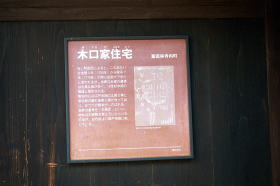 |
Tourist Information Board Located in front of the wicket of Tondabayashi station. Tourist information counter opens from 10 a.m. to 4 p.m. (Phone; 0721-24-5500j |
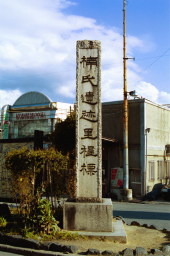 |
A tall milepost of a historic spot related to a medieval warlord, Masashige
Kusunoki.iíس¬j There are bus services available from the station to the historic spots, such as ruins of Chihaya-Akasaka castle içÔâé¬j@and Hirokawa Temple@iOìj at the foot of Kongo-Katsuragi mountains.iàéAôj |
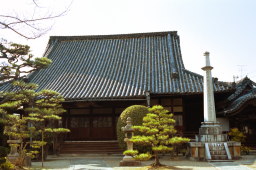 |
Koshouji Betsuin Temple Main hall and a white rock monument commemorating the founder of the temple and Jinaimachi town. Jinaimachi was originally built as a temple-town under the direction of the 14th Saint Shoshu who belonged to Koshoji in Kyoto, a temple of Jodoshinsu-Sect of Buddhism. The 14th Saint Shoshu purchased this area which had been barren land called gTonda-no-Shibah from the governor of Kawachi for 100 kan-mon (old Japanese denomination) and founded an annex Koshoji with the help of the leaders and believers of the neighboring 4 villages. |
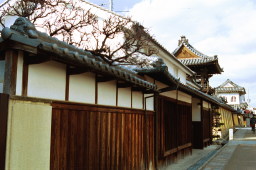 |
Viewing from resisdence of takeda family towards Koshouji temple (Bell
tower and Drum tower) (Jonomon-suji Streetj |
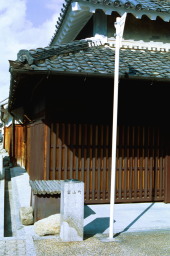 |
Aragoushi -Slatted lattice Residence of (eastj Okutani family iNot open to the public, ñöJj |
![éVåØ@ÄÈ°Æ]íêéæ¤ÉAÒ²ÆÉð·¹HªÍ©Ã¸êÄA¬Ìhqʩ窩ʹȢ\¢ÉÈÁĢܷB](0037_1.jpg) |
Jonomon-suji Street (Atemage-no-Michi) The roads called "Atemage-no-michi" mean those roads whcih do not intersect at right angles at each cross road in Jinaimachi town. This could make it diffucult for strangers to look throughout the street. These are reminants of devices to avoid being involved in the battles between feudal warlords in the 16th century. rightF@Residence of (mainj Okutani family (Not open to the public, ñöJj leftF@ Residence of (east) Okutani family iNot open to the public, ñöJj |
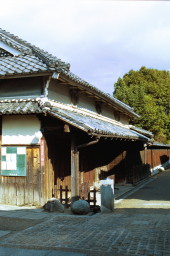 |
Residence of Hashimoto family iJonomon-uji St. Hayashi-machi St.j iNot open to the public, ñöJj |
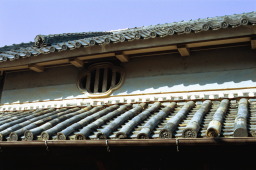 |
Mushiko-mado (Residence of Hashimoto familyj Mushiko-mado is small windows of the miniature second story of old town houses. The shape of its frame and pillars looks like a insect cage. That's the reason why the name of Mushiko-mado was derived from Mushi-kago ("an insect cage" in Japanese) The variety of its shapes differ, depending the time of construction, which characterized the exterior looks of each merchant's house. |
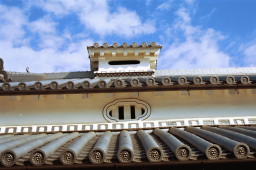 |
Mushiko-mado and Kemuri-dashi iResidence of Kiguchi familyj Kemuri-dashi is a overtopped small roof on the main building of merchants' houses for smoke ventilation. iNot open to the public, ñöJj |
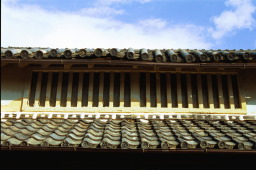 |
Mushiko-mado (Residence of Nakamura family) iNot open to the public, ñöJj |
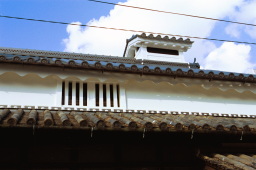 |
Mushiko-mado and Kemuri-dashi iResidence of Sugita familyj iNot open to the public, ñöJj |
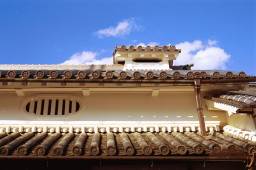 |
Mushiko-mado and Kemuri-dashi iResidence of Tamori familyj -@the harmony and contrast with black roof tiles iNot open to the public, ñöJj |
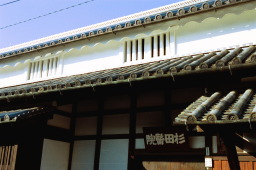 |
Mushiko-mado -@the harmony and contrast with white mortar wall (Residence of Sugita familyAJonomon-suji Streetj iNot open to the public, ñöJj |
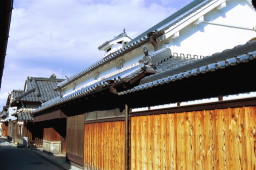 |
Residence of Kiguchi family iJonomon-suji St, Hayashi St.j iNot open to the public, ñöJj |
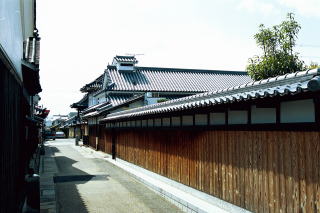 |
Residence of Sugita family iJonomon-suji St. Sakai-suji St.j iNot open to the public, ñöJj |
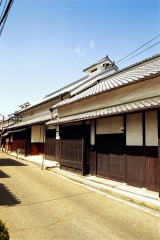 |
Residence of Tamori family (Jonomon-suji St. Sakai-suji St.j iNot open to the public, ñöJj The main building was reinstated to the original design and is characterized by a steep slope of the main roof with a small overtopped roof for smoke ventilation, the design of which is incorporated into the souvenir cookies. |
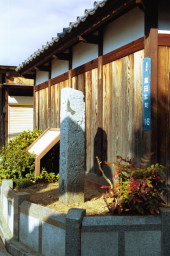 |
 Guidepost There is an old stone guidepost left at one of the entrances into the Jinaimachi town on the Higashi-Koya route. The guidepost was established in 1751. The stone-carved guidepost shows the directions as well as reminders to warn visitors, saying "Smoking and flammable items are strictly prohibited while travellers pass through the Jinaimachi town. |
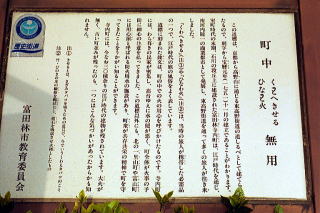 |
We may come across the residents' great consciousness and morality to prevent
the town from a fire. That might be one of the main reasons why the invaluable
heritage still remains as used to be. fortunately free from damages by a big fire and a disaster. |
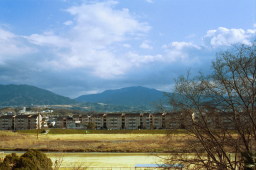 |
Riverbed of the Ishikawa River Viewing from the river terrace of Jinaimachi town, you can overlook the Ishikawa River and Kongo-Katsuragi Mountains. |

